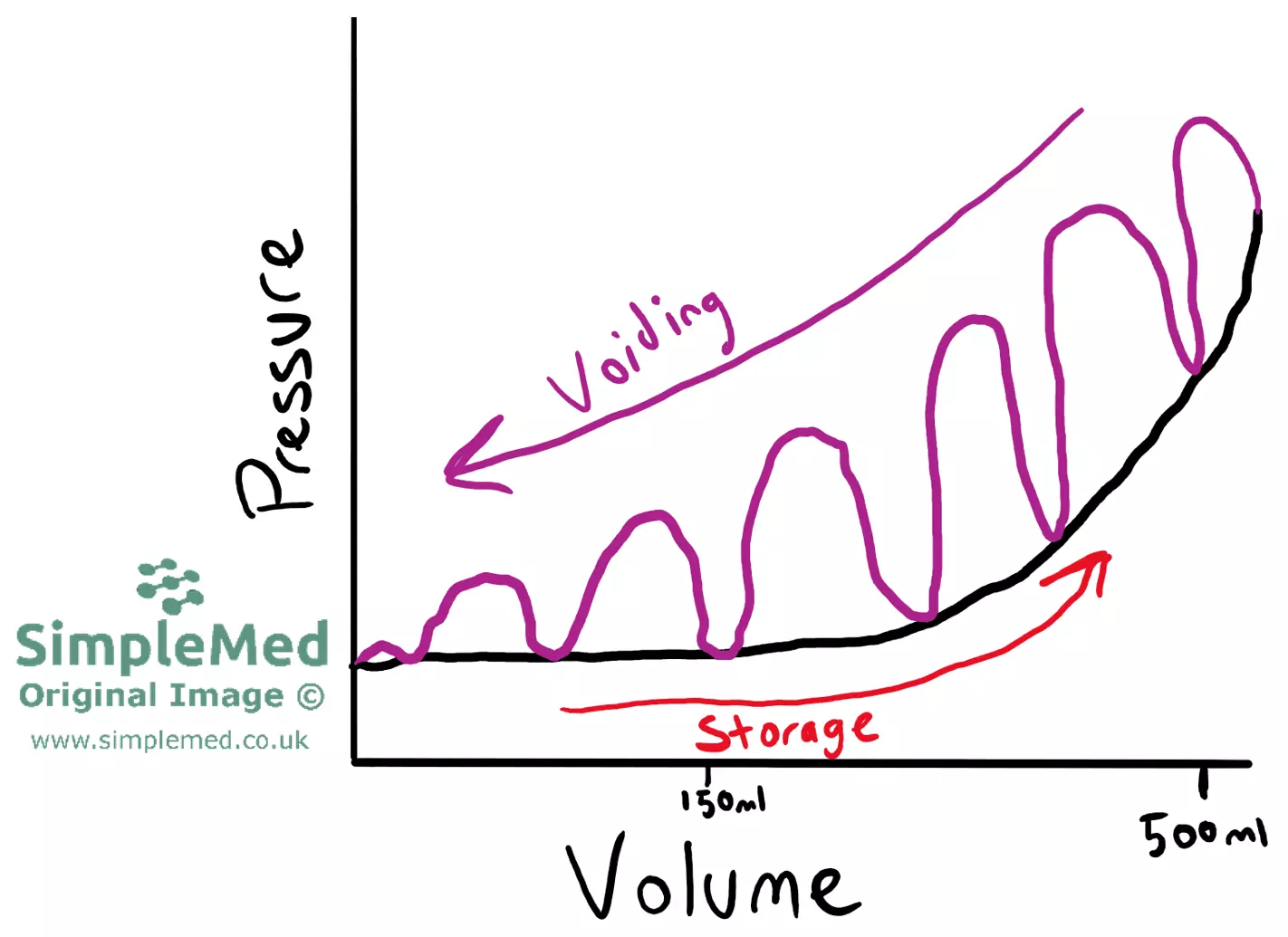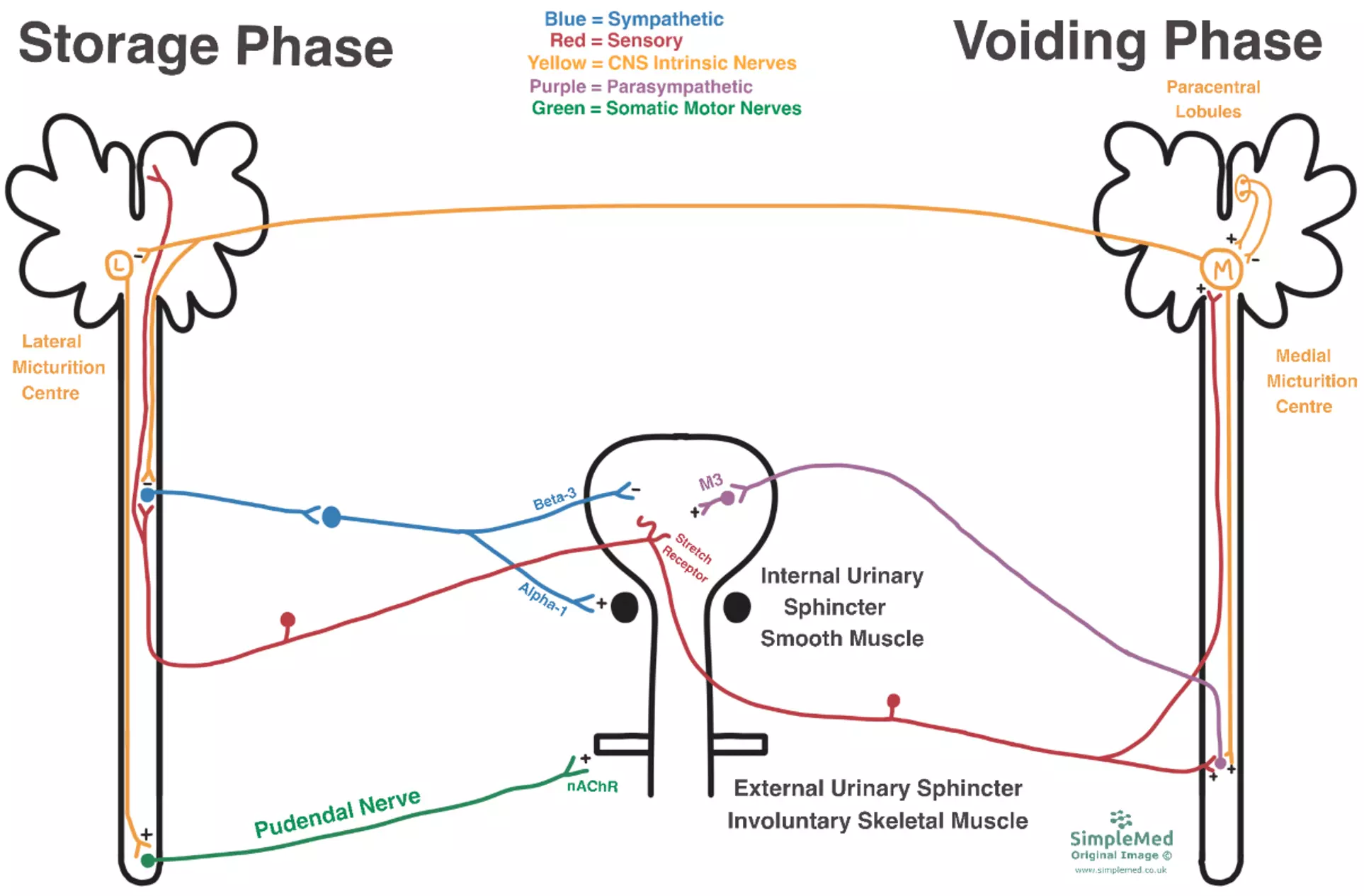Next Lesson - Diuretics
Core
Micturition is the process of passing urine. It can be split up into storage and voiding phases. These phases work antagonistically meaning they are constantly working in opposition.
During the filling phase volume increases gradually, and initially pressure stays at the same low level. After around 150ml of urine in the bladder the brain becomes aware of the bladder filling. The filling continues and after around 300ml the intra-vesical pressure rises rapidly. After 500ml the urge to void becomes overwhelming.
During the voiding phase, the detrusor muscle contracts in waves. This means that pressure increases and decreases multiple times until the full volume of the bladder is voided.
The graph below shows the relationship between intra-vesical pressure and volume.

Diagram - Graph showing the relationship between increasing intra-vesical volume and pressure
SimpleMed original by Joshua Sturgeon

Diagram - This is an overview of the neural control of storage and voiding. To the left and right are coronal sections through the brain and spinal cord. In the middle is the bladder. For clarity the storage and voiding phases are depicted separately, but in real life they are of course working together. The inhibitory neurones are shown with a small ‘-‘ sign at their insertion, and the stimulatory neurones are shown with a small ‘+’ sign
SimpleMed Original by Maddie Swannack, with contributions from Joshua Sturgeon
Stretch receptors in the bladder detect the level of filling. Sensory neurones synapse in the cortex and cause the feeling of the bladder filling.
Sensory neurones also synapse with sympathetic neurones in the spinal cord. The sympathetic neurones act to stimulate the internal urinary sphincter (IUS) through alpha-1 adrenoceptors. The sympathetic neurones also directly inhibit the detrusor muscle through beta-3 adrenoceptors – this causes progressive relaxation of the bladder during storage meaning the pressure remains constant initially.
The lateral micturition centre is located in the brain stem. It continually sends excitatory action potentials down the cord and synapses with the pudendal nerve. The pudendal nerve is a somatic motor neurone from the nerve roots S2, S3, and S4 and acts on the external urinary sphincter (EUS) through nicotinic acetylcholine receptors (nAChR). The pudendal nerve stimulates the EUS to contract, meaning the lateral micturition centre acts to retain urine.
The voiding phase involves a large amount of input from the cerebral cortex – this ensures that voiding can be postponed until a time that is convenient and socially acceptable.
The paracentral lobules in the cortex send inhibitory and excitatory action potentials to the medial micturition centre in the brain stem. The medial micturition centre directly inhibits the lateral micturition centre in order to relax the IUS and EUS, and it also stimulates parasympathetic neurones in the spinal cord.
Stretch receptors in the bladder also send excitatory action potentials to the parasympathetic neurones as well as directly stimulating the medial micturition centre when the bladder becomes full.
These parasympathetic neurones synapse with other parasympathetic neurones in the bladder. These act via stimulatory M3 muscarinic receptors and cause contraction of the detrusor muscle. This means that the medial micturition centres and parasympathetic nervous system act to encourage micturition but can be overridden by the cerebral cortex.
Cauda equina syndrome (CES) is a medical emergency which arises due to compression of the spinal nerves that exist in the spinal column below the bottom of the spinal cord (below the spinal level L2). Symptoms include bilateral sciatica, perianal anaesthesia, and loss of urinary or faecal continence.
CES can cause incontinence through a number of mechanisms:
- Compression of Parasympathetics and Motor Neurones to the Detrusor Muscle – this means the bladder fills as normal but cannot properly empty, leading to overflow incontinence when the bladder has reached maximum capacity.
- Damage to Sensory Neurones – this means patients cannot feel how full the bladder is, again leading to overflow incontinence.
- Pudendal Nerve Damage – this causes the EUS to remain open which causes the constant leakage of urine.
- Non-compression of Sympathetics – as sympathetic neurones arise from the thoraco-lumbar region of the cord, they cannot be compressed in CES as this is a pathology of below this level. This means the bladder is continually relaxed so cannot void properly. This will cause stagnation of urine so patients must be catheterised in order to prevent infection.
It is important to note a sacral spinal cord lesion will have very similar effects as CES.
A complete transection of the mid-spinal cord will destroy most of the inhibitory connections to parasympathetic neurones. This causes the parasympathetic neurones to strongly stimulate the bladder leading to strong contractions of the detrusor muscle. However, a transection would also prevent the urinary sphincter from relaxing, meaning there is no outflow for the urine. This patient needs to be catheterised to relieve the pressure.
Edited by: Dr. Maddie Swannack
Reviewed by: Dr. Thomas Burnell
- 8213

